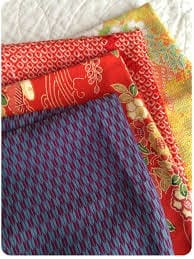The textile arts have been rural-bound treasures for centuries. Holding the keys to three distinct and distinctive textile production methods- sashito , shibori and kasuri , Japan is the mother of its own unique aesthetic heartbeat.



Generally the textiles in ancient japanese culture were used to make the kimono for different occasions .Textile arts in Japan were deeply divided by social class. The wealthy and the poor relied on different materials, techniques, and fashions which could only be used by that class. The most famous material used to make these textiles is silk . silk was only accessible to the rich. The common people made textiles from plant fibers, predominantly cotton and hemp, spun and woven into wearable garments.
Different types of textile in japanese culture
kaga Yuzen textiles



Japan’s kaga textiles has a unique method of dyeing . In this craft there are five different colour tones are used, indigo, khaki, green, dark reddish purple, and deep red. This textile features classical deep tones centering on reddish colors and floral print designs, representing the natural beauty of Kanazawa. It has delicate and unique patterns that are enhanced by the distinctive gradation fro edge to the center of each motif. The kaga was originally produced using the silk and hemp. this textile requires enormous amount of water for washing purpose so the textile was eventually made near the area which was well blessed with the rivers and water bodies .

Although quicker methods of producing designs, like machinery, are valued today, the Kaga textile process continues to use traditional handwork with many artists and craftsmen still working on it to keep the legacy of this beautiful textile.
Kyo Textiles


Kyo textiles are dye textiles . In the this textile a large range of vivid colours and a technique of pictorial designs of animals, nature and daily items are used . This technique of making the textile needs a intensive amount of labor and it totally contains handwork. This Kyo textile is a beautiful production by the elegant and sumptuous culture of Kyoto and it is popular not only in Japan but all over the world.The whole production process of Kyo textiles requires an extended period of time as it involves the collaboration of many specialized artisans with high craftsmanship.
Use of silk in the Japanese textiles

Silk is the one of the most important ant popular material used for making the japanese textile for ages . Japan produces some of the worlds finest quality of silks . these high quality silks earlier were used for making the garments for the people of upper class people int the community . People back in those days need to take permission to wear the garments made from these finest quality silk. Japan’s first exposure to silk came in the 2nd century CE, when Chinese ambassadors sent silkworms to Japan and Korean ambassadors brought woven silk cloths.
Here are some verity of silks from japanes culture .
Nishijin Brocade

Nishijin brocade is woven silk produced in the northwestern part of Kyoto. There are twelve kinds of Nishijin brocade designated by the regulations and production process of the nishijin brocade varies depending on the makers of the fabric. Initial production of Nishijin brocade began all the way back during the Kofun period (250-538AD)
There are several verities of nishijin brocades such as Tsumugi -fabric woven with thin silk threads Honshibo-ori – fabric made with textured crepe weaving and Futsu – double sided fabric with different colors and patterns on each side

This silk results in making Nishijin ori which is a high quality silk fabric which is woven when the threads of silk are dyed.
Over the years craftsmen and weavers enthusiastically producing various new products from nishijin that match the modern lifestyle. Moreover , Nishijin and Nishijin ori are registered as trademarks in order to preserve the traditional process.
Yuki Tsumugi Silk

Yuki tsumugi silk is produced in the Kinu River region . Today, the fabric made from this silk is considered as an luxury . kimonos and other garments made fro this silk are characterized by their lightness, softness, and excellent heat retaining-properties. The threads are extracted from yarn hands pun from silk floss. Threads of this silk last long without getting damaged and maintain the high quality of the textile.


The fabric made from this yarn is very comfortable to wear and has very appealing texture. Yuki tsumugi silk textile is one of the most outstanding Japanese silk fabrics that has been passed down for generations.
Thus, we can say that Japan has its own world for its textile , starting from the finest quality of silk to various techniques of weaving a beautiful and unique textiles.
Thank you
Article By Arsh Gupta
instagram : @arshgupta47

